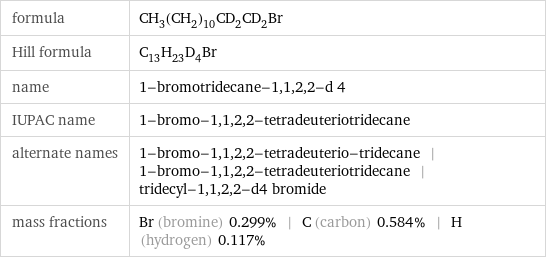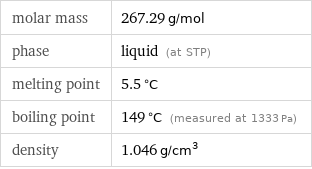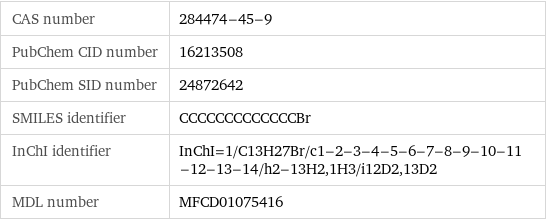Input interpretation

1-bromotridecane-1, 1, 2, 2-d 4
Chemical names and formulas

formula | CH_3(CH_2)_10CD_2CD_2Br Hill formula | C_13H_23D_4Br name | 1-bromotridecane-1, 1, 2, 2-d 4 IUPAC name | 1-bromo-1, 1, 2, 2-tetradeuteriotridecane alternate names | 1-bromo-1, 1, 2, 2-tetradeuterio-tridecane | 1-bromo-1, 1, 2, 2-tetradeuteriotridecane | tridecyl-1, 1, 2, 2-d4 bromide mass fractions | Br (bromine) 0.299% | C (carbon) 0.584% | H (hydrogen) 0.117%
Lewis structure

Draw the Lewis structure of 1-bromotridecane-1, 1, 2, 2-d 4. Start by drawing the overall structure of the molecule: Count the total valence electrons of the bromine (n_Br, val = 7), carbon (n_C, val = 4), and hydrogen (n_H, val = 1) atoms: n_Br, val + 13 n_C, val + 27 n_H, val = 86 Calculate the number of electrons needed to completely fill the valence shells for bromine (n_Br, full = 8), carbon (n_C, full = 8), and hydrogen (n_H, full = 2): n_Br, full + 13 n_C, full + 27 n_H, full = 166 Subtracting these two numbers shows that 166 - 86 = 80 bonding electrons are needed. Each bond has two electrons, so the above diagram has all the necessary bonds. There are 40 bonds and hence 80 bonding electrons in the diagram. Lastly, fill in the remaining unbonded electrons on each atom. In total, there remain 86 - 80 = 6 electrons left to draw: Answer: | |
3D structure

3D structure
Basic properties

molar mass | 267.29 g/mol phase | liquid (at STP) melting point | 5.5 °C boiling point | 149 °C (measured at 1333 Pa) density | 1.046 g/cm^3
Units

Liquid properties (at STP)

density | 1.046 g/cm^3 refractive index | 1.459
Units

Non-standard atom properties

H-2 | 4
Chemical identifiers

CAS number | 284474-45-9 PubChem CID number | 16213508 PubChem SID number | 24872642 SMILES identifier | CCCCCCCCCCCCCBr InChI identifier | InChI=1/C13H27Br/c1-2-3-4-5-6-7-8-9-10-11-12-13-14/h2-13H2, 1H3/i12D2, 13D2 MDL number | MFCD01075416